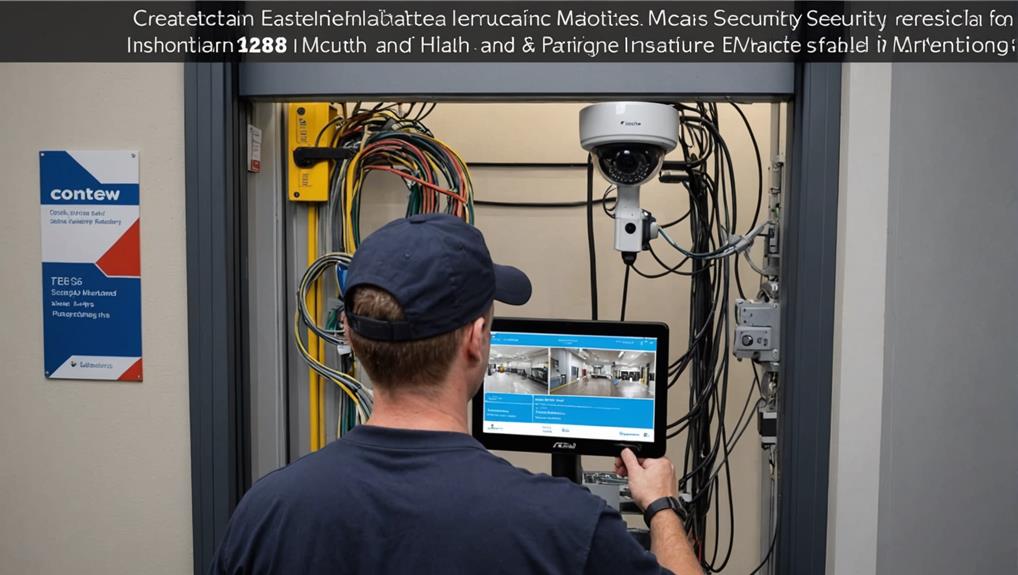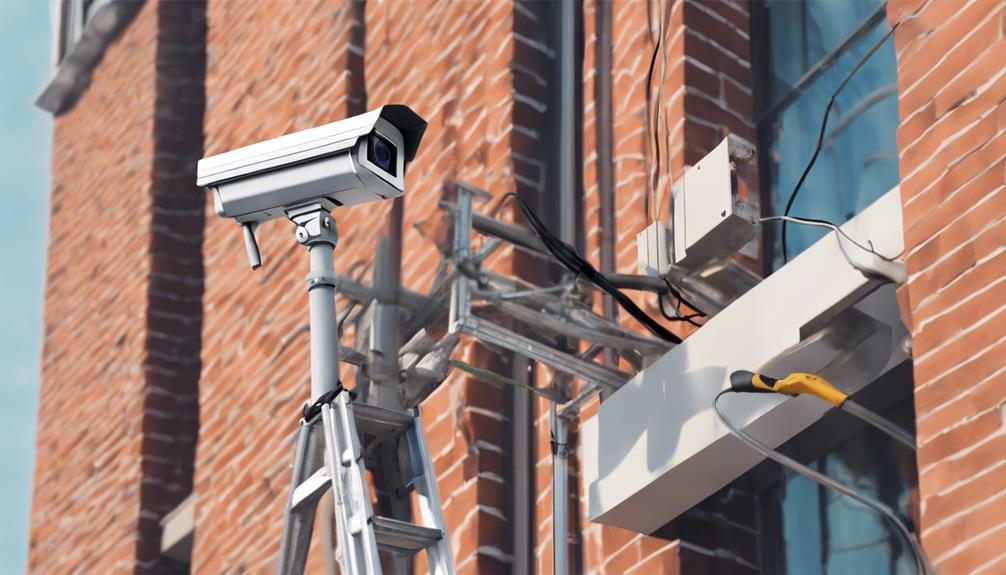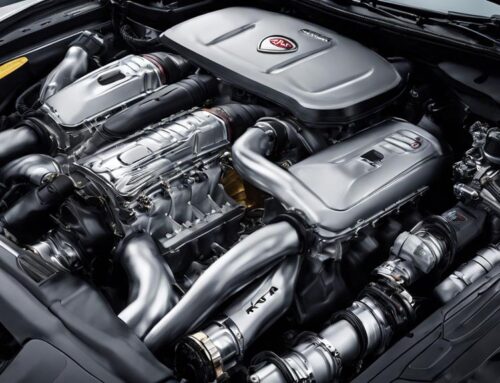For ideal protection, prioritize the correct installation and maintenance of security systems. Guarantee thorough security needs assessment to identify risks and engage employees for insights. Develop a complete security plan defining measures and responsibilities. Consider costs and features aligning with your needs. Professional installation guarantees compliance and functionality, while regular maintenance prevents vulnerabilities. Integrate advanced technology strategically, providing real-time threat detection. Train employees for system operation and emergency protocols and rely on experts for ongoing support and maintenance. By prioritizing these practices, you assure a secure environment.
Key Takeaways
- Professional installation is crucial for compliance and functionality.
- Regular maintenance checks ensure optimal system performance.
- Strategic camera placement enhances surveillance effectiveness.
- Access control systems restrict unauthorized entry efficiently.
- Remote support services offer quick issue resolution for minimal downtime.
Security Needs Assessment

Conducting a thorough security needs assessment is vital for guaranteeing the effective protection of your premises. By evaluating factors like building size, business type, and vulnerabilities, you can identify risks and security gaps.
Engaging employees in this process can offer valuable insights into security concerns and high-risk areas that need enhanced measures. Whether through internal evaluations or professional assessments, pinpointing high-risk areas is significant for developing tailored security solutions.
Incorporating specific features like facial recognition technology and remote access capabilities can boost the efficacy of your security system.
It's important to take budget constraints and available resources into account during the assessment to create a realistic and effective security plan.
Security Plan Development

To guarantee the effective protection of your premises, the development of an all-inclusive security plan is essential. When creating this plan, it's vital to assess your building size, business type, and vulnerabilities to identify potential risks and high-risk areas.
A thorough evaluation can be guided by resources like Finding the Right Security System for Your Home, which provides insights into evaluating security requirements.
A well-structured security plan should include defined security measures, outline emergency response steps for different scenarios, assign roles and responsibilities to employees, and make certain staff are familiar with procedures.
Regular preventative maintenance, such as drills and training sessions, should be scheduled to prepare employees for security incidents and guarantee effective responses.
Budget Setting and Comparison

When setting a budget for security systems, you need to carefully consider the overall costs, including equipment, installation, monitoring, and maintenance.
It's also important to understand the potential initial setup fees that may be involved.
By evaluating features and prices, you can guarantee that the chosen system aligns with both your requirements and budget constraints.
It's essential to compare various system options to find the most cost-effective solution that meets your security needs.
Cost-Effective System Options
Exploring cost-effective system options for security installations requires a strategic approach to budget setting and comparison.
To make a cost-effective choice, consider the total investment encompassing equipment, installation, and ongoing monitoring expenses. When evaluating system options, factor in the costs of components like cameras and sensors, as well as installation methods, which can impact overall expenses.
Assess monitoring choices, such as professional versus self-monitoring, as they can influence upfront and recurring costs, with professional monitoring often incurring monthly fees.
Additionally, prioritize scalability and flexibility in your budget to accommodate future security needs and upgrades.
By carefully considering these aspects, you can guarantee that your system installation remains within budget while meeting your security requirements effectively.
Comparing Features and Prices
For a thorough evaluation of security system options, it's essential to compare features and prices meticulously. When setting a budget for security systems, take into account the overall costs, including installation, maintenance, and upgrades.
Here are three key points to take into account:
- Evaluate Installation Methods: Compare the costs associated with DIY installation versus professional installation services. While DIY may seem cost-effective initially, professional installation guarantees proper setup and reduces the risk of errors that could lead to maintenance issues down the line.
- Assess Maintenance Services: Look into the maintenance packages offered by different providers. Understanding what maintenance services are included in the initial cost and what additional services may be needed in the future can help you budget more effectively and avoid unexpected expenses.
- Compare Monitoring Options: Take into account the long-term costs and effectiveness of professional monitoring services versus self-monitored systems. Professional monitoring may come at a higher price but offers continuous surveillance and immediate response to security breaches, potentially reducing maintenance needs.
Best Practice Installation

To achieve ideal security system functionality, it's paramount to prioritize best practice installation methods. Hiring a professional installation company guarantees compliance with local regulations and industry standards, optimizing the security system's effectiveness and reliability.
Proper placement of cameras and sensors is critical for maximum coverage, requiring strategic planning based on the layout and vulnerabilities of the property. While choosing your home security installation, it's important to weigh the benefits of professional versus DIY setups.
It's necessary to follow manufacturer guidelines during installation to prevent complications and enhance the performance of security systems. After installation, conducting thorough testing is required to verify the functionality of all components and allow for immediate troubleshooting of any issues.
Additionally, scheduling regular security system maintenance checks post-installation is essential to address potential issues early and guarantee the long-term reliability of the system. By adhering to these best practices, you can assure that your security system operates at its best, providing you with peace of mind and protection for your property.
Utilizing Security Cameras Effectively

When it comes to guaranteeing the effectiveness of your security system, one key aspect that can't be overlooked is the strategic utilization of security cameras.
To optimize the use of security cameras for your property, consider the following:
1. Strategic Placement: Guarantee cameras cover high-traffic areas, entry points, and blind spots for thorough coverage and to deter unauthorized access effectively.
Additionally, consider the latest advancements in alarm and lock technologies to complement your camera setup.
2. High-Definition with Night Vision: Invest in high-definition cameras with night vision capabilities to enhance visibility during low-light conditions, improving overall security monitoring.
This technological enhancement guarantees that you capture clear footage regardless of the time of day.
3. Motion Detection Integration: Integrate motion detection technology to reduce unnecessary recordings, enabling efficient storage management and quick review of relevant footage.
Access Control Implementation

Within the domain of security system implementation, the integration of access control systems stands out as a significant measure for enhancing the safeguarding of your premises. Access control systems, utilizing key cards, biometrics, and PIN codes, restrict entry to authorized personnel only, bolstering security effectively.
Sometimes, professional installation is recommended for residential security systems to guarantee everything is set up correctly. These systems can be seamlessly integrated with existing security measures, enabling centralized access management and real-time monitoring of entry and exit logs.
To guarantee peak functionality and security, regular maintenance of access control systems is essential. This maintenance includes monitoring and servicing components like readers, locks, and software.
By implementing access control, organizations can experience a significant reduction in unauthorized access incidents, with studies indicating up to a 50% decrease in security breaches.
Employee Training

For effective utilization of security systems within your organization, employee training plays an essential role in guaranteeing ideal security measures.
When it comes to employee training and maintenance procedures, consider the following:
1. Comprehensive Training: Provide detailed instructions on system operation, emergency protocols, and maintenance procedures to equip your staff with the necessary skills to respond effectively to security incidents.
It's vital to also focus on making sure that the security systems remain functional and effective over time by incorporating routine checks and updates as part of the training.
2. Regular Drills: Schedule regular training sessions and drills to keep employees updated on security protocols and reinforce their roles during security incidents.
This practice guarantees that staff members are prepared and confident in executing security procedures.
3. Security Awareness: Educate employees on identifying suspicious activities, utilizing alarm systems, and handling surveillance tools.
Enhancing security awareness among staff members contributes to a proactive security culture within your organization.
Security System Trends

You'll find that security systems are rapidly evolving to incorporate advanced technologies like AI and machine learning, revolutionizing threat detection capabilities.
This integration allows for more sophisticated threat detection and response, enabling systems to learn and adapt to new threats over time.
The integration of IoT-connected devices is reshaping the security landscape, facilitating seamless communication for enhanced monitoring and control.
As businesses adapt to industry changes, cloud-based solutions are becoming increasingly popular, offering scalable storage options and remote accessibility.
Emerging Technology Integration
Integrating emerging technologies into security systems is revolutionizing the industry, enhancing protection capabilities and streamlining operations. Here are three key ways this integration is shaping the future of security systems:
- Artificial Intelligence (AI) Enhancements: By incorporating AI into security systems, the monitoring center can now detect threats more effectively by analyzing patterns and identifying anomalies in real-time. This not only improves response times but also helps in reducing false alarms, ensuring a more efficient security protocol.
- Internet of Things (IoT) Integration: Security systems are increasingly leveraging IoT technology to create interconnected devices that communicate and share data. This interconnectedness leads to more thorough and automated security solutions, enhancing the overall efficiency of monitoring and control within the system.
- Facial Recognition and License Plate Recognition: The inclusion of features like facial recognition and license plate recognition in smart security systems enhances access control and monitoring capabilities for residential and commercial properties. These technologies provide an added layer of security and convenience in managing and securing properties effectively.
Impact on Security Landscape
As security systems continue to evolve with the integration of cutting-edge technologies like Artificial Intelligence (AI) and the Internet of Things (IoT), the security landscape is witnessing significant transformations.
The installation process of security systems now incorporates AI, enabling real-time threat detection and predictive analytics to identify vulnerabilities proactively. This advancement enhances security by preventing potential risks from escalating.
Moreover, the increased interconnectivity facilitated by IoT devices allows for remote monitoring and control, revolutionizing how security systems are managed.
Cloud-based solutions are also reshaping the security landscape, offering scalability, accessibility, and cost-efficiency compared to traditional on-premises systems. Businesses of all sizes are turning to these solutions for enhanced security measures.
With the evolving cybersecurity threats like ransomware and DDoS attacks, organizations are prioritizing robust security measures and regular software updates to mitigate risks effectively.
Additionally, compliance with industry regulations such as GDPR and CCPA is steering investments towards security systems that not only safeguard assets but also guarantee data privacy and consumer protection.
Adaptation to Industry Changes
To adapt to the rapidly evolving landscape of the security industry, staying abreast of the latest trends is essential. Incorporating cutting-edge technologies into security systems is vital for maximizing protection and efficiency.
Here are three key trends shaping the industry:
- Integration of Artificial Intelligence (AI): Leveraging AI in security systems enhances threat detection capabilities, leading to a 30% increase in incident response efficiency. Stay updated on AI-driven technologies to strengthen your security measures.
- Adoption of Internet of Things (IoT): The IoT trend allows for a more interconnected security ecosystem, enabling remote monitoring and control via smartphones. Embrace IoT devices to improve accessibility and surveillance capabilities.
- Shift to Cloud-Based Storage: Cloud solutions offer secure storage for surveillance data, with scalable options that can grow alongside your business needs. Embrace cloud-based storage for flexibility and reliability in managing security data.
Final Considerations

For ideal system performance and long-term security effectiveness, it is crucial to evaluate a few final factors when installing and maintaining security systems. When it comes to installation, prioritize hiring certified professionals to guarantee compliance with local regulations and peak system performance. For maintenance, develop an all-encompassing plan that includes routine checks, software updates, and emergency response protocols to enhance reliability and security. Regular maintenance checks can address minor issues early, extending the system's lifespan and reducing unexpected repair costs. Utilize advanced monitoring options like remote support services for timely issue resolution and minimal service disruptions. Stay informed about emerging security technologies and trends to continuously enhance system effectiveness and adapt to evolving threats.
| Final Considerations | ||
|---|---|---|
| Prioritize Certified Professionals | Develop All-Encompassing Maintenance Plan | Utilize Advanced Monitoring Options |
| Guarantee Compliance and Peak Performance | Routine Checks and Software Updates | Remote Support Services for Timely Resolution |
Expert Assistance and Support

When seeking expert assistance and support for your security system, consider the benefits of remote support services for quick issue resolution.
On-site technician notifications through services like Tech TrackerSM can enhance communication and preparedness during maintenance visits.
Remember that regular system maintenance is vital to prevent unexpected costs and guarantee the longevity of your security infrastructure.
Additionally, be aware that ongoing costs such as equipment updates and repairs can accumulate over time, making regular maintenance even more important.
Remote Support Benefits
With remote support services for security systems, you gain access to expert assistance and support from certified professionals, ensuring prompt issue resolution and minimizing downtime.
Here are some benefits of utilizing remote support:
- Quick Issue Resolution: Remote support enables speedy problem-solving, often within 15 minutes, reducing the need for on-site visits and keeping your security system operational.
- Cost Management: Pre-budgeted support plans help organizations control costs by avoiding unexpected expenses related to emergency repairs and service calls, allowing for better financial planning.
- 24/7 Assistance: Advanced and Premium support plans offer round-the-clock after-hours assistance, ensuring that expert help is always available to address critical security system issues promptly.
On-Site Tech Notifications
Enhancing communication and guaranteeing a seamless service experience, the On-Site Tech Notifications system provides real-time alerts to keep you informed about technician visits for your security system.
When a technician is on the way, you'll receive notifications with the technician's name and estimated arrival time. These notifications go the extra mile by including a photograph of the technician, making it easier for you to identify them when they arrive.
To guarantee efficient communication, the system establishes a designated contact person at your location before the service. This proactive approach helps streamline the process and guarantees a quick response to your service requests.
In case you need technical support, rest assured that certified professionals with an average tenure of over nine years will be available on-site to assist you promptly.
With this system in place, you can trust that your security cameras and alarm system are in expert hands, ready to provide you with reliable service whenever you need it.
System Maintenance Importance
To guarantee the continued ideal functioning of your security systems, expert assistance and support play a vital role in maintaining the integrity and effectiveness of your installations.
Here are three reasons why expert maintenance is essential:
- Optimal Functioning: Regular maintenance guarantees that all components of your security systems, such as cameras and sensors, are functioning properly, maximizing protection against potential breaches.
- Regulatory Compliance: Adhering to regulations like Order INT / 316/2011 for alarm systems is important to maintain the effectiveness and legality of your security installations.
- Risk Reduction: Preventive maintenance practices help identify vulnerabilities early on, reducing the chances of costly security breaches.
Engaging experts for ongoing maintenance guarantees prompt resolution of issues, extending the lifespan and reliability of your security systems.
Frequently Asked Questions
What Is Security System Maintenance?
Security system maintenance involves regular checks and updates to guarantee all components function properly, reducing vulnerability to breaches.
Preventive, corrective, and predictive measures help identify issues before they escalate, guaranteeing timely repairs.
A well-documented plan outlines review deadlines, inspections, and compliance with regulations.
These efforts not only maintain operational integrity but also improve user trust and industry standards compliance, leading to cost savings and peak system performance and longevity.
What Is an Example of Security Maintenance?
Regularly inspecting security cameras guarantees they function at their best, deterring potential threats.
Promptly fixing malfunctioning alarm sensors prevents security breaches, assuring timely alerts for unauthorized entries.
Predictive maintenance anticipates system failures, enabling proactive measures to enhance reliability.
Stay current with software updates to patch vulnerabilities and boost performance against cyber threats.
Conduct routine security audits to evaluate existing measures and find areas for improvement, enhancing overall security posture.
How Much Does It Cost to Install a New Security System?
Installing a new security system can range from $500 to $10,000, depending on the complexity and features.
Professional installation adds 10% to 30%.
Monthly monitoring fees range from $15 to $60.
DIY systems cost $200 to $1,000, with additional costs for services like cloud storage.
Smart home integration and advanced sensors can increase the total investment.
How Often Should a Security System Be Serviced?
For ideal security, service your system regularly.
By scheduling preventive maintenance every six months, you can catch issues early.
Aim for annual thorough inspections to confirm system integrity.
Apply software updates quarterly to stay protected.
Monthly checks on monitoring systems are essential for functionality.
After significant changes, evaluate your service to assure your security needs are met.
Prioritize maintenance to keep your system reliable and effective in safeguarding your property.
Conclusion
In summary, installing and maintaining a security system is essential for protecting your property and assets. By conducting a security needs assessment, developing a plan, setting a budget, and utilizing best practices, you can enhance the safety of your space. Remember to stay updated on security system trends and seek expert assistance when needed. With proper installation, maintenance, and employee training, you can guarantee the effectiveness of your security measures. Stay vigilant and secure.









